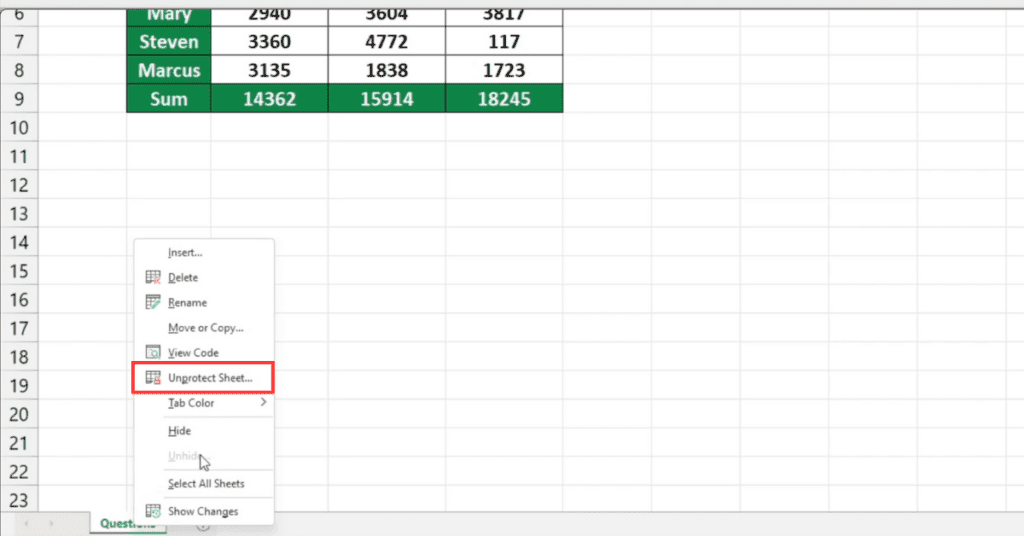Unlock Excel Sheets: Easy Unprotection Guide

The idea of safeguarding Excel sheets through password protection is a widely used practice for securing sensitive or proprietary data. While this provides peace and safety, it can also occasionally become a nuisance when you need to access your own data or when a colleague leaves a company and the password is lost. This guide is designed to walk you through the steps to unlock Excel sheets, offering a comprehensive look at both legitimate and ethical methods to regain access. We aim to ensure that your focus remains on productivity, not on overcoming software barriers.
Why Do People Protect Excel Sheets?

Before delving into how to unprotect Excel sheets, understanding why people do this can provide insight into the importance of protection:
- Privacy and Confidentiality: Sensitive financial data, HR records, or personal details are often protected.
- Error Prevention: Locking down cells or sheets prevents unintended changes, maintaining the integrity of data.
- Intellectual Property: Formulas and calculations, especially complex ones, are protected to avoid unauthorized modifications.
Legitimate Methods to Unlock Excel Sheets

Using Built-In Excel Features

Microsoft Excel has features designed for easy removal of protection:
- Unlocking via Password Prompt: If you have the password, you can unlock the sheet by going to the
Reviewtab, selectingUnprotect Sheet, and entering the password. - Developer Tab Option: If the VBA project is not protected, you can use VBA to remove sheet protection. Here are the steps:
- Enable Developer Tab in Excel.
- Open VBA editor (Alt+F11 or Developer > Visual Basic).
- Insert a new module and copy-paste the following code:
Sub RemoveAllSheetProtection() Dim wSheet As Worksheet For Each wSheet In ActiveWorkbook.Worksheets wSheet.Unprotect Password:=“yourpassword” Next wSheet End Sub - Run the macro, replacing “yourpassword” with the actual password.
👀 Note: Be cautious when dealing with VBA macros; they can contain code to harm your system or Excel files if sourced from unknown origins.
When You’ve Forgotten the Password

If the password is forgotten and no one else knows it, you might need to resort to:
- Third-Party Tools: Use specialized software that claims to recover or reset Excel passwords. Ensure the tool’s legitimacy and compatibility with your Excel version.
- VBA Macros: Advanced users can leverage online forums to find scripts that bypass protection without knowing the password. Remember, this can compromise file integrity.
⚠️ Note: Use third-party tools at your own risk, as they might breach Microsoft’s licensing agreement.
Alternative Methods and Approaches

Using XML Editing

For Excel files saved in .xlsx format, you can utilize XML editing:
- Change the file extension from .xlsx to .zip.
- Open the zip, navigate to
xl\worksheets\sheet[n].xml. - Edit the file to remove the
- Save, then revert the file back to .xlsx.
💡 Note: Modifying Excel files at this level might corrupt them or lead to data loss. Always back up before attempting any edits.
Considering Professional Services

If all else fails and the information is critical, professional data recovery services might be your best option. They often have:
- Advanced techniques to retrieve data.
- Skills in handling file corruption issues.
Legal and Ethical Considerations

Unlocking someone else’s protected Excel sheet without permission is generally against the law and ethical guidelines. Always consider:
- The legal ramifications of unauthorized access.
- The ethical implications, especially in professional environments.
As we wrap up this unlocking journey, it's crucial to remember that Excel's protection features are there for a reason. Accessing your own protected data due to forgotten passwords is one thing, but attempting to access someone else's protected sheets can have far-reaching consequences. This guide has provided various methods to unlock Excel sheets, emphasizing the importance of using these tools and techniques ethically and legally. Always ensure you have the right to access the data, keep backups, and understand the implications of using third-party tools.
Is it legal to unlock an Excel sheet?

+
Unlocking an Excel sheet you own or have permission to access is generally legal. However, accessing someone else’s protected Excel sheet without permission is not. It violates both legal and ethical standards.
Can using third-party tools harm my computer?

+
Yes, third-party tools can pose risks, including potential malware infection or data corruption. Always ensure the software comes from a reputable source and is compatible with your system.
What are the alternatives to unlocking an Excel sheet?

+
If you cannot unlock the sheet, consider contacting the person who applied the protection for the password or assistance. Alternatively, you might need to recreate the data or use professional recovery services if critical information is locked within.
How can I prevent losing Excel passwords?

+
Store passwords securely, perhaps using password management software or sharing passwords with trusted colleagues. Also, document passwords carefully or use protection features sparingly for sheets you use frequently.
What should I do if the file becomes corrupted after trying to unlock it?

+
Restore from a backup if available, or if there’s no backup, use professional data recovery services or attempt to repair the file with Excel’s built-in repair tool.



